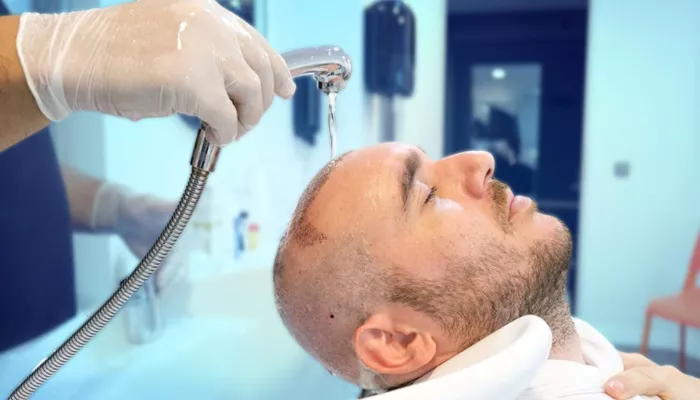A hair transplant is a significant investment in one’s appearance and self-confidence. Proper aftercare, especially washing your hair correctly, is crucial for ensuring the success and longevity of the transplant. This guide provides comprehensive instructions on how to wash your hair after a hair transplant, highlighting essential tips and precautions to follow during the recovery period.
Understanding the Hair Transplant Procedure
Hair transplant surgery involves extracting hair follicles from a donor area, typically the back or sides of the head, and implanting them into the balding or thinning areas. The two main techniques are Follicular Unit Extraction (FUE) and Follicular Unit Transplantation (FUT). Regardless of the method used, post-operative care is crucial for optimal results.
Why Washing Is Important
Washing your hair after a transplant helps remove blood, scabs, and any residual topical anesthesia from the scalp. It also promotes healing by keeping the area clean and reducing the risk of infection. However, it’s essential to follow specific guidelines to avoid damaging the newly implanted grafts.
When to Start Washing
Initial Waiting Period
Typically, surgeons recommend waiting 48 to 72 hours after the procedure before washing your hair. This waiting period allows the grafts to stabilize and reduces the risk of dislodging them.
Consult Your Surgeon
Always follow your surgeon’s specific instructions regarding the timing and method of washing your hair. Different surgeons may have slightly varying recommendations based on their techniques and your individual case.
Preparation for Washing
Gather Supplies
Before washing your hair, gather the necessary supplies:
Mild, sulfate-free shampoo recommended by your surgeon
A clean cup or bowl for rinsing
A clean, soft towel
Sterile saline solution (if advised by your surgeon)
Create a Comfortable Environment
Ensure you have a comfortable and clean environment to wash your hair. A bathroom sink or a shower with gentle water pressure works best.
Step-by-Step Guide to Washing
Day 1 to Day 5
Step 1: Gentle Rinsing
Fill a cup or bowl with lukewarm water.
Gently pour the water over the transplanted area to rinse away any blood or debris.
Avoid using direct water pressure on the grafts.
Step 2: Applying Shampoo
Dilute a small amount of the recommended shampoo with water.
Gently apply the diluted shampoo to the recipient area using a light tapping motion with your fingertips.
Do not rub or scratch the scalp.
Step 3: Rinsing Shampoo
Use the cup or bowl to rinse the shampoo off gently.
Ensure all shampoo is removed to prevent irritation.
Step 4: Patting Dry
Use a clean, soft towel to pat the area dry gently.
Avoid rubbing the towel on the scalp.
Day 6 to Day 10
Step 1: Increasing Pressure Gradually
After the initial five days, you can start using a shower with gentle water pressure.
Ensure the water is lukewarm and not too hot.
Step 2: Applying Shampoo
Apply the recommended shampoo directly to your scalp.
Use a gentle circular motion with your fingertips to clean thescalp.
Be cautious around the transplanted area.
Step 3: Thorough Rinsing
Rinse thoroughly to remove all shampoo residues.
Ensure the water flow is not too strong.
Step 4: Patting Dry
Pat the scalp dry with a clean, soft towel.
Avoid any vigorous rubbing.
SEE ALSO: Does Alcohol Affect Hair Transplant?
Post-Wash Care
Avoid Direct Sun Exposure
Protect your scalp from direct sun exposure for at least two weeks post-surgery. Wear a loose-fitting hat or use an umbrella when going outside.
Avoid Physical Activities
Refrain from strenuous physical activities, including heavy lifting and intense exercise, for the first two weeks. Sweating can increase the risk of infection and dislodge grafts.
Sleeping Position
Sleep with your head elevated for the first week to minimize swelling. Use multiple pillows or a recliner to keep your head above heart level.
Common Concerns and Solutions
Scabbing
It’s normal to develop scabs around the transplanted grafts. These should not be picked or scratched. They will naturally fall off within 10 to 14 days. Proper washing helps manage scabbing.
Itching
Mild itching is common as the scalp heals. Avoid scratching the area. If itching persists, consult your surgeon for a suitable anti-itch solution.
Redness and Swelling
Redness and swelling are typical in the first few days post-surgery. Applying cold compresses (not directly on the grafts) and keeping your head elevated can help reduce swelling.
Long-Term Care
Continued Gentle Washing
Continue using a mild shampoo and gentle washing techniques for at least one month post-surgery. After that, you can gradually return to your regular hair care routine.
Follow-Up Appointments
Attend all scheduled follow-up appointments with your surgeon. They will monitor your progress and provide additional care instructions.
Hair Growth Expectations
Transplanted hair typically falls out within the first few weeks, followed by new growth starting around the third to fourth month. Full results can take up to a year to become visible.
Conclusion
Proper washing after a hair transplant is essential for the success of the procedure and the health of your new hair. By following the guidelines provided by your surgeon and taking careful steps during the washing process, you can ensure a smooth recovery and optimal results. Always consult your surgeon for personalized advice and report any unusual symptoms or concerns promptly.

